Which Austin streets are named after historic Black figures?
- Oops!Something went wrong.Please try again later.
- Oops!Something went wrong.Please try again later.
AUSTIN (KXAN) — In recent years, several Austin streets have taken on new names to honor prolific Black figures who have had influence here in Austin and beyond.
Some of those figures are internationally renowned, such as Martin Luther King Jr. Others, like Azie Taylor Morton, are remembered as educators and racial equality advocates.
Here’s a look at some of the roadways named in their honor, and how they helped shape the Austin of today.
Azie Morton Road
Jutting off Barton Springs Road in south Austin is Azie Morton Road, named in memory of historic Black educator and prominent government figure Azie Taylor Morton.
Morton was born in Dale, Texas before relocating to Austin to attend high school at the Texas Blind, Deaf and Orphan School. The school was a “charity sponsored school” for Black children due to there being no designated schools for Black people in her hometown, per historic documents.
Morton graduated high school at 16 years old before attending Huston-Tillotson College (now Huston-Tillotson University). She graduated with a Bachelor of Science degree in commercial education in 1956.
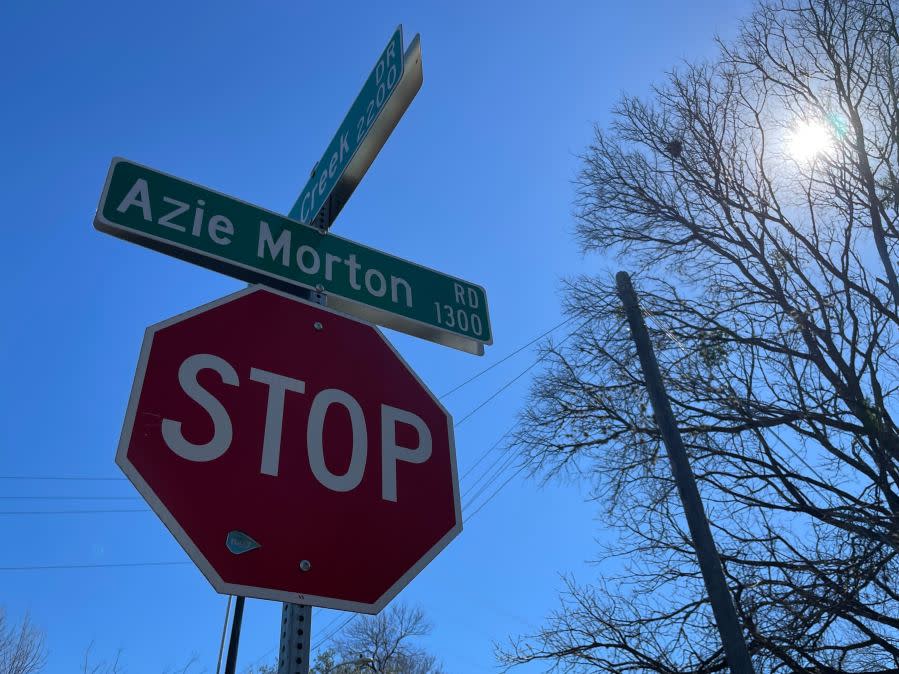
In Austin, Morton pushed back against segregationist policies at city institutions, swimming in Barton Springs Pool despite city regulations barring Black people from using it. “Swim-ins” were some of the ways Black people challenged racist policies early in the civil rights movement, per documents.
“In addition to Azie Morton’s courage, prominent residents like Bertha
Means, Willie Mae Kirk, Joan Means Khabele, Saundra Kirk, members of the Universalist Unitarian Church, students from Austin High School and several others in the community all worked collectively over a period of several years to integrate the Springs,” city historic documents read.
Morton began her educational career working for the Texas AFL-CIO before she was invited to work for then-President John F. Kennedy’s Committee on Equal Employment Opportunity in Washington, D.C. She later also served on the President’s Committee on Equal Opportunity in Housing.
One of Morton’s lasting legacies is her status as the only Black person to serve as Treasurer of the United States. Former President Jimmy Carter appointed her to serve in his cabinet from 1977 to 1981.
Following her service as U.S. Treasurer, she relocated back to Austin to assist with her alma mater, Huston-Tillotson. Some of her work included serving as a member of its Alumni Association to help mentor students. From 1999 to 2001, she served on the Austin Housing Authority Board of Commissioners, per documents.
In 2018, city leaders renamed Robert E. Lee Road to Azie Morton Road in her memory.
J.J. Seabrook Drive
A small roadway connected to Martin Luther King Jr. Boulevard honors the memory of Dr. John Jarvis (J.J.) Seabrook.
Seabrook moved to Austin and became an educator before eventually serving as president of Huston-Tillotson College (now Huston-Tillotson University). His community work in Austin included service as a pastor and as a member of several community groups.
During the 1970s, Seabrook focused on Austin’s 19th Street renaming. East of Interstate 35, the roadway had already been renamed to honor King’s memory. However, west of the interstate, the road remained 19th Street.
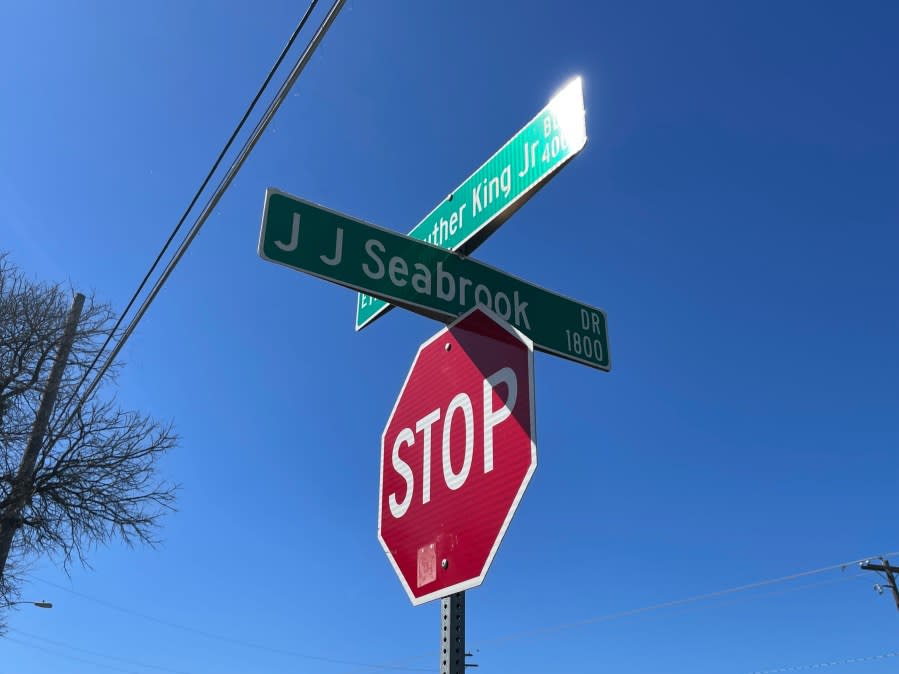
It was Seabrook’s efforts in the 1970s that helped ensure Martin Luther King Jr.’s legacy would be memorialized in Austin through the renaming of 19th Street. While arguing before Austin City Council in favor of the complete road renaming on May 1, 1975, Seabrook suffered a heart attack and died later that evening.
In Seabrook’s memory, the bridge connecting Martin Luther King Jr. Boulevard east and west of I-35 is named in his honor. Just before the intersection of East Martin Luther King Jr. Boulevard and Springdale Road, a small side street is named J.J. Seabrook Drive.
His namesake is also immortalized in the King-Seabrook Chapel at Huston-Tillotson University; the J.J. Seabrook Greenbelt off East Martin Luther King Jr. Boulevard; and in the J.J. Seabrook Neighborhood Association in east Austin.
Maggie Mayes Street
Austin City Council voted nearly two years ago to change the name of Confederate Avenue in central Austin to Maggie Mayes Street. The new namesake paid homage to Maggie Mayes, a noted Black educator.
Clarksville originally was created as a slaved quarters for those enslaved under Gov. Elisha Pease, according to historic documents from the Clarksville Community Development Corporation.
Following the emancipation of enslaved people in Texas in 1865, a portion of the land was released for freedmen to use. Six years later, Charles Clark — a formerly enslaved man — purchased two acres of land and developed the area now known as West 10th Street.
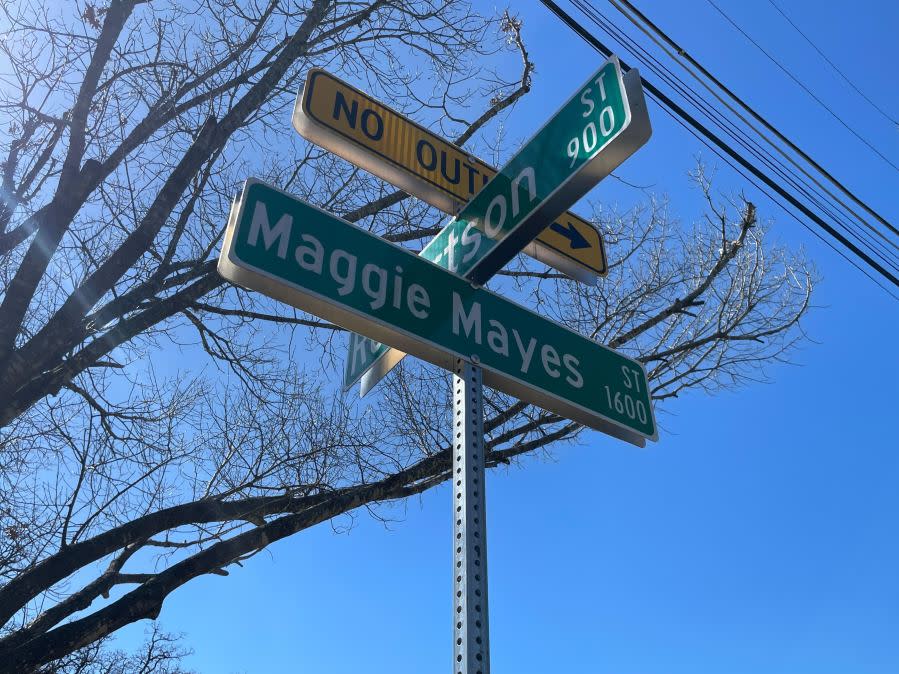
“This area formed the nucleus of what would become the community of Clarksville, which according to tradition, Clark envisioned as a place where former slaves could reunite with their families and friends, direct their own lives and freely practice their religion,” reads documents published by the Clarksville CDC.
Later on, Mayes founded the first school in the Clarksville neighborhood, home to Austin’s earliest freed Black community. Her husband, state legislator Elias Mayes, served in the Texas Legislature for several years, during a time where few Black legislators served the state.
“We don’t know as much about Maggie Mayes as we need to,” former Austin City Council Member Kathie Tovo told KXAN in March 2022. “And so my hope is that, in recognizing the significant contributions we know she did as a Black educator, that we’ll also, in the years to come, learn even more about the other ways in which she helped shape not just her neighborhood, but also our city for the better.”
The street, now named after Mayes, is located between Open Door Preschool and Mathews Elementary School.
Martin Luther King Jr. Boulevard
Many know the life and legacy of Martin Luther King Jr., a prolific civil rights activist and one of the leaders of the movement from 1955 until his assassination in 1968. But some might not know the history of how, exactly, Austin’s former 19th Street became Martin Luther King Jr. Boulevard.
Seabrook is the man who helped ensure King’s legacy would be honored across Austin. He spoke at an Austin City Council meeting in May 1975 to advocate for the name change, when he collapsed and ultimately died from a heart attack.
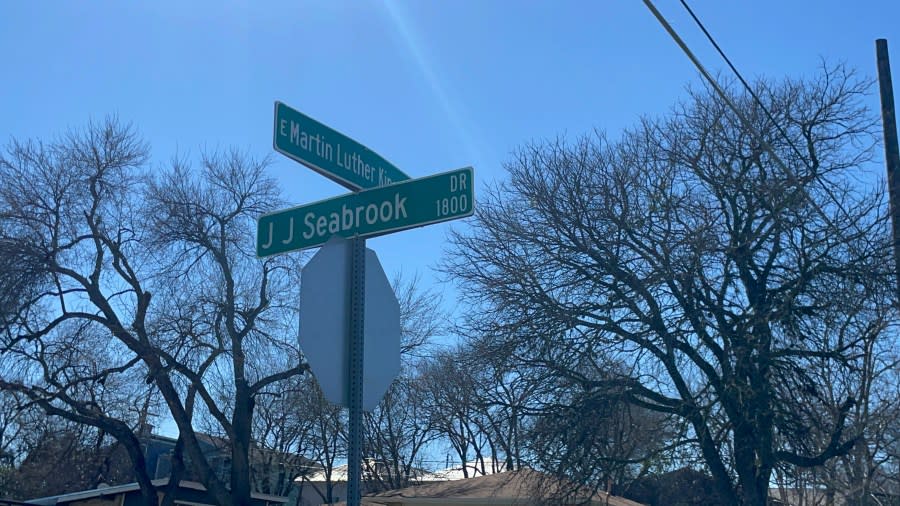
Despite Austin City Council approving the renaming of 19th Street on April 10, 1975, businesses along the road west of I-35 pushed back at the change, and West 19th Street remained. Some of the reasons people opposed to the change gave publicly were that the costs of sign changes would be substantial and it would inconvenience businesses to update their addresses.
On May 1, 1975, Seabrook stressed to council the vote had been taken and the adoption of the complete name change had been approved. During his testimony, Seabrook suffered a heart attack, and later died that same evening.
Five days following his death, Austin City Council voted to approve the full renaming of 19th Street to honor King.
Richard Overton Avenue
Hamilton Avenue in east Austin is also named Richard Overton Avenue, in memory of Texas veteran and Austinite Richard Overton. He passed away in December 2018 at 112 years old, and was the oldest living World War II veteran in the U.S. prior to his death.
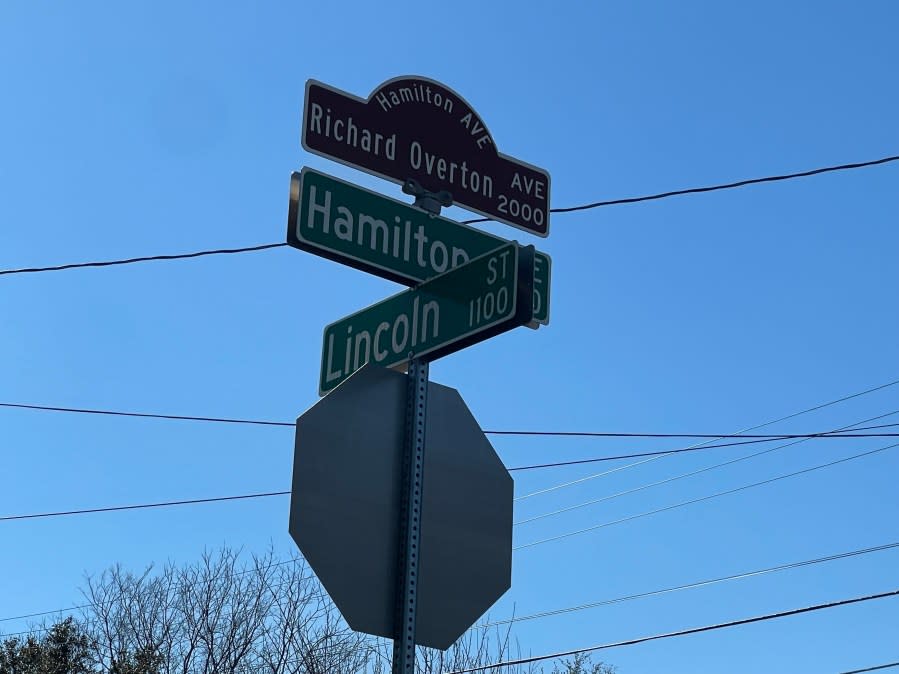
Regarded by close friends as the “grandfather of Austin,” Overton was known for his signature cigar and wide smile — two features incorporated into his memorial monument at his burial site at the Texas State Cemetery.
“As we sat on his porch and smoked cigars and sipped whiskey, he welcomed everyone into his house, into his world, and just loved everyone,” his longtime friend friend Allen Bergeron told KXAN in April 2022. “And so for me, it’s about the final chapter, even the final paragraph for me. He was just a dear friend.”
William Holland Avenue
Near the Brentwood neighborhood in central Austin lies William Holland Avenue, a roadway named after a historic Black educator in Austin.
Born enslaved, Holland and his brothers are presumed to be the sons of Capt. Bird Holland, a white man who bought their freedom and moved them to Ohio in the late 1850s, city documents write. Holland served in the Union Army’s Sixteenth United States Colored Troops before attending Oberlin College for two years after the war. He then returned to Texas and began teaching in multiple counties as well as many city schools in Austin.
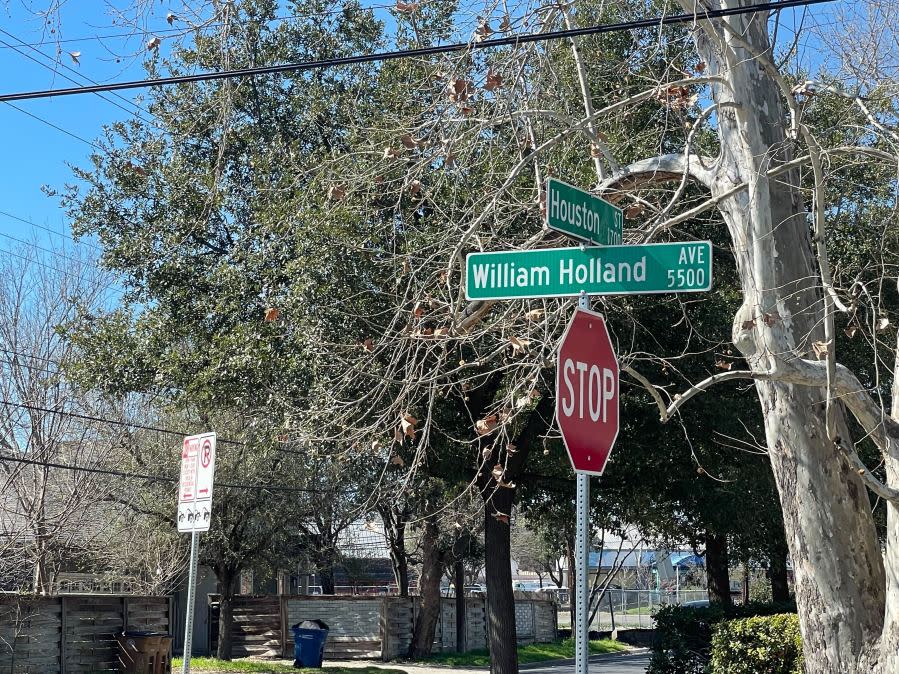
Holland’s life and legacy centered around his work to advance high quality educational opportunities for Black students in Texas. That dedication included service as a state representative, county commissioner and work as a delegate to the Texas Colored Men’s Convention along with two National Republican Conventions, per city documents.
Holland established a school for Black children with disabilities in April 1887, which served as one of several predecessor institutions of the Texas School for the Blind and Visually Impaired. Former Texas Gov. Lawrence Sullivan Ross named Holland to serve as the school’s first superintendent; his appointment made history as the first Black man in the United States to lead a public institution.
In 2018, Austin City Council approved renaming Jeff Davis Avenue in Holland’s honor.
Possible sites to be renamed in the future
A memo sent to the Austin City Council and the mayor from the city’s Equity Office last month outlined guidance from renaming city assets that currently have names tied to the Confederacy.
The January memo is a follow up from a 2020 council resolution that “directed staff to support an educational process and collaborate with residents to identify City assets for renaming,” per that memo.
Three main assets that could be considered for renaming included Plantation Road, Dixie Drive and Metz Park and Pool. The park is named after Hamilton M. Metz, a firefighter in Austin who later served in the Confederate Army during the Civil War.
Despite Metz Neighborhood Park still going by its original name, the city had already renamed its adjacent recreation facility the Mendez Recreation Center. The facility is named after Rodolfo “Rudy” Mendez, an Austinite who dedicated his life to mentorship and dance teaching in east Austin. He founded the Ballet East Dance Company and also developed the nationally renowned “Dare to Dance” program, per city documents.
For the latest news, weather, sports, and streaming video, head to KXAN Austin.

